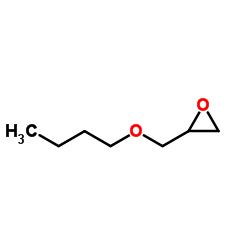

丁基缩水甘油醚结构式

|
常用名 | 丁基缩水甘油醚 | 英文名 | Butyl glycidyl ether |
|---|---|---|---|---|
| CAS号 | 2426-08-6 | 分子量 | 130.185 | |
| 密度 | 0.9±0.1 g/cm3 | 沸点 | 177.0±0.0 °C at 760 mmHg | |
| 分子式 | C7H14O2 | 熔点 | N/A | |
| MSDS | 中文版 美版 | 闪点 | 54.4±0.0 °C | |
| 符号 |




GHS02, GHS05, GHS06, GHS08 |
信号词 | Danger |
|
Encapsulation of fish oil with N-stearoyl O-butylglyceryl chitosan using membrane and ultrasonic emulsification processes.
Carbohydr. Polym. 123 , 432-42, (2015) Fish oil-loaded microcapsules were prepared from oil-in-water emulsions using N-stearoyl O-butylglyceryl chitosan as shell material. The emulsions were prepared by both membrane and ultrasonic emulsification processes under variable conditions to examine the ... |
|
|
Fine Structure of the Integumentary Cuticles and Alimentary Tissues of Pycnophyid Kinorhynchs Pycnophyes oshoroensis and Kinorhynchus yushini (Kinorhyncha, Homalorhagida).
Zoolog. Sci. 32 , 389-95, (2015) Integumentary and alimentary tissues were ultrastructurally examined in two pycnophyid kinorhynchs, Pycnophyes oshoroensis and Kinorhynchus yushini, to elucidate some aspects of their ecology. The body is entirely enveloped by an epicuticle layer with no gaps... |
|
|
Nanoparticles of alkylglyceryl-dextran-graft-poly(lactic acid) for drug delivery to the brain: Preparation and in vitro investigation.
Acta Biomater. 23 , 250-62, (2015) Poly(lactic acid), which has an inherent tendency to form colloidal systems of low polydispersity, and alkylglyceryl-modified dextran - a material designed to combine the non-immunogenic and stabilising properties of dextran with the demonstrated permeation e... |
|
|
[The study of immunotoxicity of butyl glycidyl ether].
Zhonghua Yu Fang Yi Xue Za Zhi 22(1) , 11-3, (1988)
|
|
|
The effect of chemical modification of amino acid side-chains on collagen degradation by enzymes.
J. Biomed. Mater. Res. B. Appl. Biomater. 81(1) , 1-11, (2007) In this study, the effects of specific chemical modifications of amino acid side-chains on the in vitro enzyme degradation of type I collagen was studied. Two monofunctional epoxides of different size and chemistry were used to modify lysine and methylglyoxal... |
|
|
The evaluation of the epoxide diluent, n-butylglycidyl ether, in a series of mutagenicity assays.
Environ. Mutagen. 2(4) , 521-30, (1980) The epoxide diluent, n-butylglycidyl ether (n-BGE), was tested in vitro for mutagenicity using Salmonella typhimurium and for transforming ability in mouse embryo cells (BAlb/3T3-A31-1-13). The n-BGE produced base-pair type mutations in S typhimurium strains ... |
|
|
Unscheduled DNA synthesis induced in human lymphocytes by butyl glycidyl ethers.
Mutat. Res. 102(2) , 193-200, (1982) Unscheduled DNA synthesis (UDS) was examined in normal human peripheral blood lymphocytes (HPBL) exposed to n- and tert.-butyl glycidyl ethers (BGE). n-BGE, which is currently used as a major reactive diluent for industrial epoxy resin systems, has been impli... |
|
|
Dominant lethal effects of n-butyl glycidyl ether in mice.
Mutat. Res. 124(3-4) , 225-33, (1983) Using the dominant lethal assay, the ability of n-butyl glycidyl ether to induce mutations in male mice was investigated. No significant dose-related changes either in pregnancy rates or in average number of implants per pregnant female were found. However, w... |
|
|
n-Butylglycidyl ether: the formation of a novel metabolite of an epoxide.
Drug Metab. Dispos. 13(2) , 263-4, (1985)
|
|
|
Metabolism and disposition of n-butyl glycidyl ether in F344 rats and B6C3F1 mice.
Drug Metab. Dispos. 35(12) , 2218-24, (2007) The disposition of [(14)C]-labeled n-butyl glycidyl ether (BGE, 3-butoxy-1,2-epoxypropane) was studied in rats and mice. The majority of a single p.o. dose (2-200 mg/kg) was excreted in urine (rats, 84-92%; mice, 64-73%) within 24 h. The rest of the dose was ... |